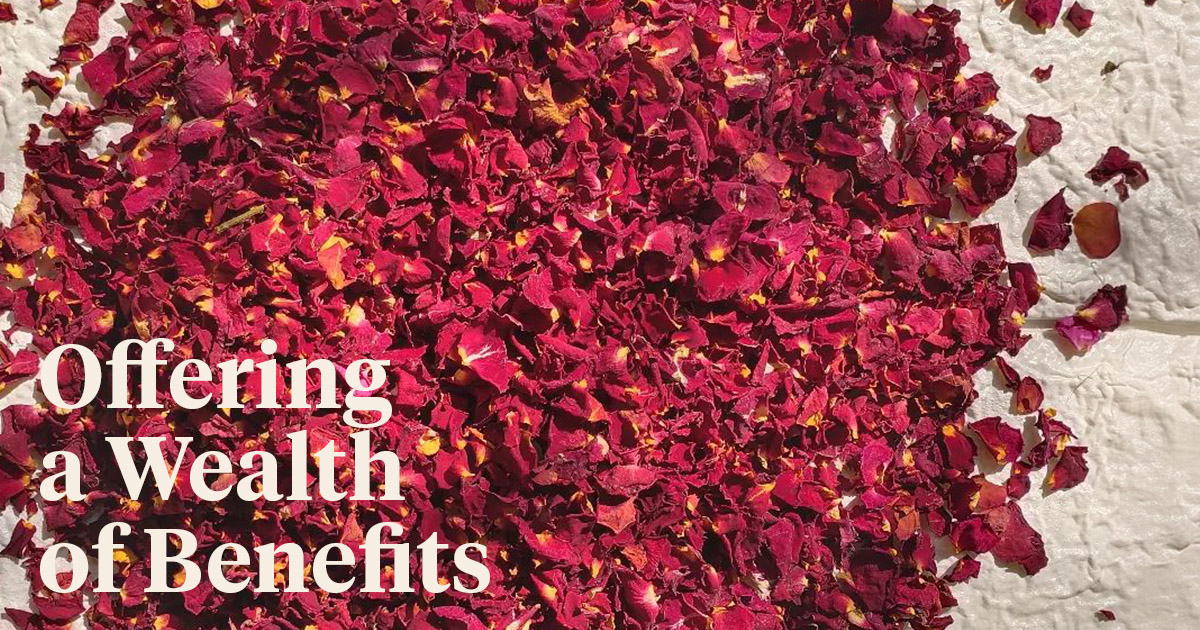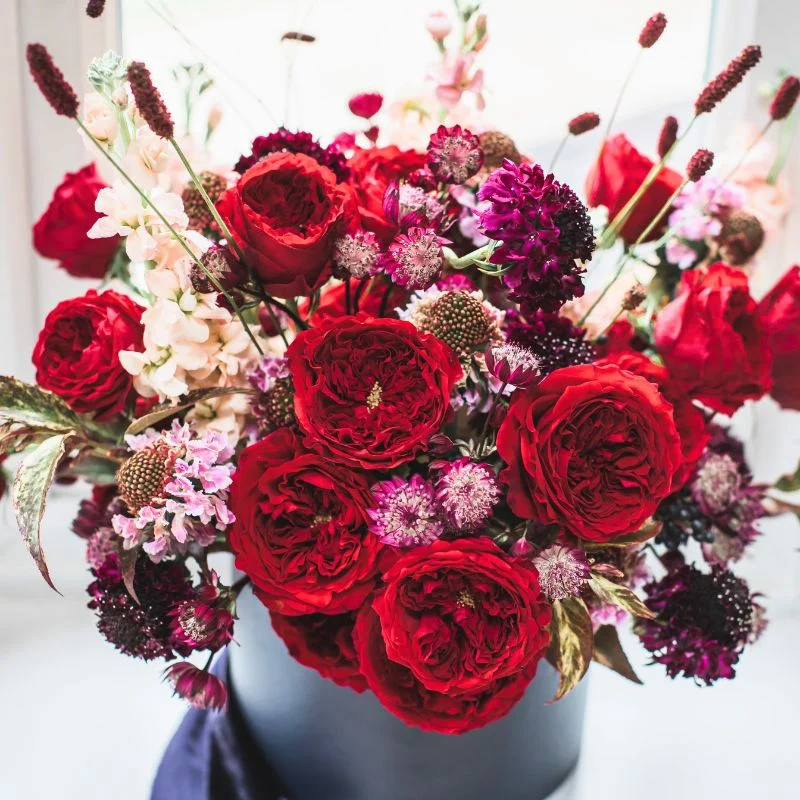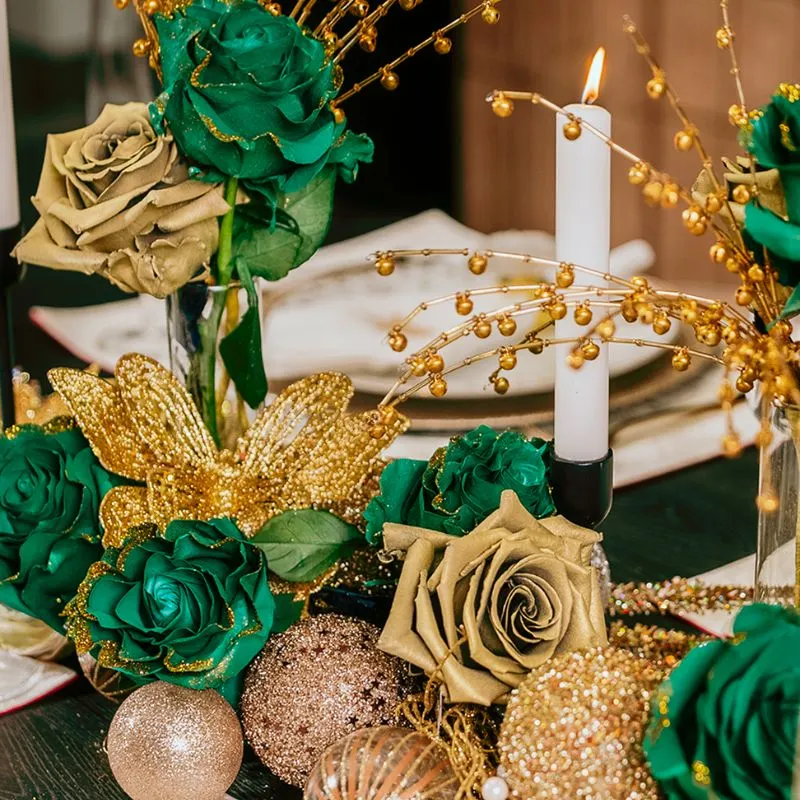Rose petals have captivated humanity for millennia, featuring prominently in cultural, culinary, and medicinal traditions.
From ancient rituals to modern skincare, rose petals offer a wealth of benefits. Whether you’re a gardener, culinary enthusiast, or beauty seeker, this guide delves into the history, symbolism, uses, and benefits of rose petals.
Some examples rose petals are used for are:
- Parties and special events
- traditions
- rose water and oil
- traditional medicine
- cosmetics
- gourmet cuisine
But first, let's talk some history.
Rose Petals - A Historical Journey
Rose petals have long transcended mere decoration, playing crucial roles in various traditions. Persians used rose water in cuisine, while Eastern cultures incorporated rose petals in herbal medicine. In Egypt, Cleopatra famously adorned her quarters with rose petals to enchant Roman general Mark Antony. Ancient Romans associated rose petals with luxury, scattering them at banquets and using them in baths. Emperor Nero once had a dining room ceiling release rose petals for an opulent experience.

Medieval medicine valued the Apothecary's Rose for its healing properties, treating ailments like headaches and indigestion. During the Middle Ages, roses symbolized the Virgin Mary, with petals used in religious practices. The 15th-century War of the Roses saw the York and Lancaster Rose become symbolic of rival houses. The era also introduced the first true red rose from China, marking a significant botanical milestone.
Today, rose petals continue to be celebrated for their timeless beauty and diverse applications.
Rose Petals in Traditions and their Meanings
In various cultures, rose petals have been central to ceremonial practices. At weddings, a flower girl scatters petals along the aisle, symbolizing the bride's journey to a fruitful union and fertility. In religious rituals, Hindu ceremonies use rose petals in offerings, symbolizing devotion, while Christian traditions adorn altars with them, reflecting divine beauty. Rose petals also play roles in romantic traditions, from strewn beds to love spells, symbolizing romance and enchantment.
Today, they maintain their charm and symbolic power, used in expressions of love, sacred rituals, and emotional healing, continuing to convey deep emotions and traditions across the world.

Meaning Behind Rose Petal Colors - Understanding the Spectrum of Emotions
Rose petals are a language of their own, speaking volumes through their vibrant variety of colors with each one carrying its own story and significance, transforming a simple flower into a messenger of deep emotions and sentiments.
3/4 more lines, with internal linking to meaning of colors
More about the symbolism of red roses in the article the meaning of red roses.
Common Rose Petal Colors and Their Symbolism
Red, white, pink, yellow, and orange rose petals each carry unique symbolism. Red petals symbolize love and passion, and they are historically linked to Aphrodite, representing eternal love and desire.
White petals signify purity and new beginnings, commonly seen at weddings and memorials. Pink petals convey admiration, gratitude, and grace, popular in bridal bouquets and baby showers.
Yellow petals stand for friendship and joy, perfect for celebratory occasions, though once linked to jealousy in the Victorian Era. Orange petals represent enthusiasm and energy, ideal for lively celebrations and achievements.
The Charm of Uncommon and Exotic Rose Petal Colors
Less common and exotic rose petal colors carry unique symbolism. Blue petals, created through dyeing, represent the unattainable and mysterious, ideal for expressing deep sentiments.
Lavender and purple petals symbolize enchantment and majesty, perfect for romantic occasions. Black petals, despite their somber appearance, signify rebirth and new beginnings, often used in gothic cultures.
Green petals symbolize growth and harmony, making them suitable for conveying well wishes. Bi-colored and striped petals add visual interest and nuanced meanings, ideal for artistic arrangements.

The Uses and Benefits of Rose Petals
Rose petals are not only beautiful but also remarkably versatile. Their natural properties make them a staple in traditional medicine, cosmetics, and gourmet cuisine, enriching our lives with their subtle yet profound effects.
The Health Benefits of Rose Petals
Rose petals provide numerous health benefits, making them a cherished ingredient in traditional and modern medicine. They are known to improve digestion, reduce stress, and enhance skin health.
Additionally, the petals are packed with essential nutrients and antioxidants that contribute to overall health and wellness.
Nutritional Value
While rose petals are primarily valued for their fragrance and beauty, they also offer some nutritional benefits. They are low in calories and rich in water content, making them a hydrating addition to your diet.
Rose petals contain small amounts of vitamins A, C, and E, which are essential for maintaining healthy skin, boosting the immune system, and supporting overall health.
Additionally, rose petals provide minerals such as calcium, iron, and potassium, which are vital for bone health, oxygen transport, and electrolyte balance.
Antioxidant Properties
One of the most significant benefits of rose petals is their high antioxidant content. Antioxidants help combat oxidative stress and protect the body from free radical damage, which can lead to chronic diseases and aging.
The antioxidants in rose petals, such as flavonoids and polyphenols, help reduce inflammation, enhance skin health, and support the immune system.

The Edible Wonders of Rose Petals
Rose petals bring a touch of elegance and a burst of flavor to a variety of culinary creations. Their delicate fragrance and subtle taste make them a versatile ingredient in both sweet and savory dishes as well as beverages and decorative elements, bringing a hint of floral sweetness to any recipe.
Popular Dishes and Recipes
Rose petals have found their way into numerous dishes and recipes worldwide.
In Middle Eastern cuisine, they are used to flavor rice dishes, such as the fragrant Persian saffron rice.
Desserts like Turkish delight and rose petal jam showcase their sweetness.
Rose-flavored juice is also popular among South Asian and Gulf countries.
Making Rose Water and Rose Oil
Rose water and rose oil are staple ingredients in many culinary and skincare products.
To make rose water, simmer fresh rose petals in distilled water until the petals lose their color, then strain and bottle the liquid.
Rose oil is typically made through steam distillation or by infusing rose petals in a carrier oil. It is a potent ingredient in perfumes and skincare products, providing a rich, floral essence that soothes and revitalizes the skin.
Rose Petal Tea
Rose petal tea is a soothing and aromatic beverage, perfect for relaxing moments, known for its health benefits.
To make this tea, simply steep dried rose petals in hot water for about 5 to 10 minutes. The resulting infusion has a light, floral flavor and is known for its calming properties.
Rich in antioxidants and vitamin C, rose petal tea can boost your immune system, improve digestion, and reduce stress.
Use as Edible Decoration
Rose petals make exquisite edible decorations for a variety of dishes. They can be used to adorn cakes, cupcakes, and pastries, adding a touch of sophistication and romance.
Additionally, rose petals can be crystallized with sugar to create a beautiful garnish for desserts.
Fresh or dried petals can also be scattered over desserts, incorporated into frosting, or frozen into ice cubes for a decorative touch.
In savory applications, scatter fresh petals over salads or use them to decorate serving platters for a visually stunning presentation.

Rose Petals as Natural Beauty Boosters - Benefits for Skin and Hair
Rose petals are a powerhouse of natural benefits for both skin and hair.
Packed with vitamins, antioxidants, and anti-inflammatory properties, they help rejuvenate the skin and nourish the hair.
Rose Water as a Natural Toner
Rose water balances the skin’s pH, tightens pores, and removes lingering impurities. Its soothing, hydrating nature suits all skin types, including sensitive and acne-prone skin.
It calms redness and irritation, leaving skin refreshed.
To use, apply rose water to a cotton pad and sweep across the face and neck. Its mild astringent properties ensure smooth, clear skin.
Anti-Aging and Anti-Inflammatory Properties
Incorporating rose-infused products into your skincare routine can reduce fine lines and provide a natural glow. Packed with antioxidants like vitamin C and polyphenols, rose petals combat free radicals, reducing signs of aging.
These antioxidants protect the skin, promote collagen production, and improve elasticity for a youthful appearance. Additionally, their anti-inflammatory properties soothe redness and irritation, benefiting conditions like rosacea.
DIY Skincare Recipes
Creating DIY skincare recipes with rose petals is an enjoyable and effective way to harness their natural benefits. Try these simple recipes at home:
- Rose and Honey Face Mask: Mix 1/4 cup of fresh rose petals, 2 tablespoons of honey, and 1 tablespoon of yogurt. Apply to face, leave for 15-20 minutes, then rinse. This mask hydrates, soothes, and brightens the skin.
- Rose Water and Aloe Vera Gel: Blend fresh rose petals with aloe vera gel for a soothing skin gel, or mix equal parts rose water and aloe vera gel for a refreshing mist.
- Rose Petal Hair Rinse: Steep petals in hot water for 30 minutes. Strain and cool, then use as a final rinse after shampooing for shiny, soft hair.
- Rose Petal Body Scrub: Blend 1 cup of sugar, 1/2 cup of coconut oil, and 1/4 cup of dried rose petals. Use in the shower to exfoliate and moisturize skin, leaving it smooth and fragrant.

Rose Petals as the Nature's Pharmacists - Medicinal Uses of Rose Petals
Used in various traditional and modern healing practices, rose petals offer a natural remedy for a range of ailments. From easing digestive issues to relieving stress, the medicinal benefits of rose petals make them a valuable addition to any natural health regimen.
Traditional and Ayurvedic Uses
In Ayurveda, rose petals are revered for their cooling and soothing properties. They balance the pitta dosha, which governs heat and metabolism.
Used in herbal formulations, rose petals treat ulcers, inflammation, and heart problems. They are also included in Ayurvedic teas and oils to promote emotional well-being and calm.
Traditional Chinese medicine uses roses to regulate qi, reduce stress, and improve blood circulation.
Benefits for Digestion, Menstrual Health, and Stress Relief
Rose petals offer health benefits for digestion, menstrual health, and stress relief. They act as a mild laxative and improve bile flow, aiding fat digestion and relieving constipation.
For menstrual health, rose petals help regulate periods and reduce cramps due to their antispasmodic properties.
Drinking rose petal tea can ease menstrual discomfort and promote a regular cycle. Their soothing aroma and calming properties reduce stress and anxiety, promoting relaxation.

Creative and Decorative Uses of Rose Petals
Rose petals, with their delicate beauty and enchanting fragrance, are perfect for various creative and decorative purposes. Their versatility makes them a favorite for home decor, aromatherapy, and special event decorations, adding a touch of elegance and romance to any setting.
Home Decor and Aromatherapy
Incorporating rose petals into home decor creates a serene, pleasing environment. Use dried rose petals in potpourri with essential oils for a continuous aroma in decorative bowls.
Rose petals can also be embedded in homemade candles, releasing a gentle scent when lit. Rose-scented sachets placed in drawers or under pillows promote relaxation and restful sleep.
Rose water spray can refresh and purify the air, reducing stress and anxiety, and making your home a tranquil haven.
Romantic Flourishes in Rose Petals for Wedding and Event Decorations
Rose petals have long been a symbol of romance and beauty, making them a popular choice for weddings and other special events. Their versatility allows for numerous decorative possibilities, enhancing the ambiance and creating memorable experiences.
Ideas for Ceremonies and Celebrations
For weddings, rose petals scattered down the aisle by the flower girl create a romantic path for the bride. They can decorate tables, adding elegance to centerpieces and place settings. Create a rose petal canopy or backdrop for photos.
At anniversaries or milestone birthdays, use rose petals to decorate cakes and desserts. Floating rose petals in water bowls with candles create enchanting table decorations. For outdoor events, line paths with rose petals, guiding guests with beauty and fragrance.

Welcoming the Beauty and Benefits of Rose Petals
Rose petals are far more than mere botanical adornments; they are a multi-faceted treasure trove of beauty, health benefits, and creative potential.
From their rich historical significance and symbolic meanings to their practical applications in cooking, skincare, and home decor, rose petals continue to enchant and inspire.
Whether you're incorporating them into a luxurious skincare routine, using them to enhance your culinary creations, or adding a touch of elegance to your home and special events, rose petals bring a timeless charm and a variety of benefits.
Embrace the versatility and allure of rose petals, and let their delicate beauty enrich your life in countless ways. Their natural splendor and vivid use truly make them a gift from nature worth celebrating.
Choosing the Right Rose Varieties for Their Petals
Selecting the right rose variety is essential for successful gardening. Species roses, like Rosa rugosa, are hardy and disease-resistant, ideal for naturalized settings.
Old Garden Roses, such as Damask and Bourbon, offer nostalgic charm and greater disease resistance, thriving in well-drained soil and sunny spots.
Modern roses, including hybrid teas and floribundas, are bred for extended bloom periods and varied colors.
These require regular care, such as fertilization and pruning, to maintain their vibrant appearance, making them perfect for specific traits like color and bloom size.

Harvesting and Drying Rose Petals
Rose petals, with their versatile uses, require careful harvesting and drying to maintain their quality. Whether you're using them for culinary, medicinal, or decorative purposes, knowing the best harvesting and drying techniques is essential for preserving their quality.
Techniques for Gathering Rose Petals
Harvest rose petals early in the morning after dew evaporates but before the sun’s heat reduces their oils. Choose roses just starting to open. Use sharp scissors to cut stems at an angle, promoting regrowth.
Gently pluck petals by holding the bloom’s base and pulling each petal away. Discard damaged petals to maintain quality. Place harvested petals in a shallow container for good air circulation, preventing mold.
This method ensures the petals remain fresh and aromatic, ready for drying or use in various applications.
From Fresh to Forever: How to Dry Rose Petals
Drying rose petals allows you to enjoy their beauty and fragrance long after the bloom has faded. There are several methods to dry rose petals, each with its advantages.
Air Drying
This is the most traditional method and involves spreading the petals in a single layer on a clean, dry surface such as a mesh screen or paper towel.
Place them in a well-ventilated area away from direct sunlight. Turn the petals occasionally to ensure even drying. This method can take several days but retains the petals' natural color and fragrance effectively.
Using Dehydrator
A food dehydrator is a quick and efficient way to dry rose petals. Arrange the petals in a single layer on the dehydrator trays, making sure they do not overlap.
Set the dehydrator to its lowest temperature setting, usually around 35°C to 46°C (95°F to 115°F). Check the petals regularly, and within a few hours, they should be crisp and dry.
Oven Drying
Preheat your oven to the lowest setting, typically around 65°C (150°F) to 82°C (180°F). Spread the petals on a baking sheet lined with parchment paper. Place the sheet in the oven and keep the door slightly ajar to allow moisture to escape.
Check the petals frequently and remove them once they are dry, which should take about 30 minutes to an hour. Be cautious with this method to avoid burning the petals.
Microwave Drying
This method is the quickest but requires careful attention. Place a single layer of rose petals between two paper towels on a microwave-safe plate.
Microwave on low power in 30-second intervals, checking each time, until the petals are dry. This method is best for small batches and can help retain the petals' properties if done correctly.
To preserve the color and fragrance of dried rose petals, store them in an airtight container in a cool, dark place. Adding a silica gel packet can help absorb any residual moisture.

References
- Baydar, H., 2006. Rose Water and Rose Oil. Euro Cosmetics, 14(6), pp.13-17.
- Rădulescu (Corpaş), L., Bordean, D.-M., Hădărugă, N.G., Megyesi, C.I., and Rinovetz, A.E., 2021. Nutritional data evaluation study on rose petals, ginger root, and lemon. Journal of Agroalimentary Processes and Technologies, 27(4S), pp.515-520.
- Malakar, M., 2022. Dried rose petals: From the kitchen to the boudoir. Indian Horticulture, 66(5).
- Nowak, R., Olech, M., Pecio, Ł., Oleszek, W., Los, R., Malm, A., and Rzymowska, J., 2013. Cytotoxic, antioxidant, antimicrobial properties and chemical composition of rose petals. Journal of the Science of Food and Agriculture.
- Trail, G., 2008. You Grow Girl: The Groundbreaking Guide to Gardening. Touchstone.
- Gaskins, S., 2012. The Modern Rose. Smithsonian Gardens Blog, 31 August.
- Cyrino, Monica S. (2010), Aphrodite, Gods and Heroes of the Ancient World, New York and London: Routledge, ISBN 978-0-415-77523-6
- Dey, A. and Dubey, S.K., 2023. History and concepts. In: Nanocosmetics. 1st ed. CRC Press, pp.15.
- Pet'ko, L. and Faut, M., 2021. The magic of the Queen of Egypt in the rose Cleopatra. December 2021, 10(4). DOI: 10.32370/IA_2021_12_23.










